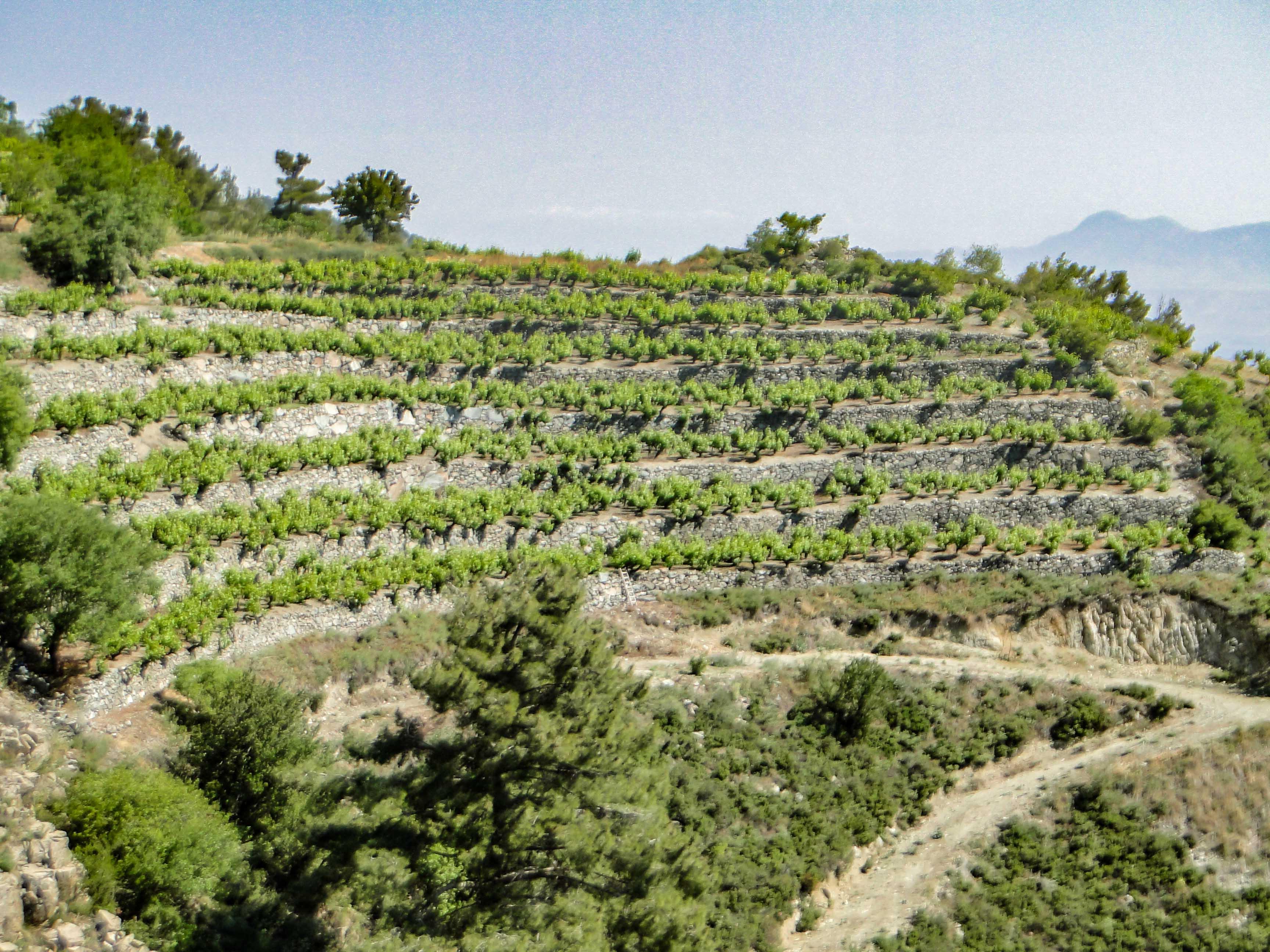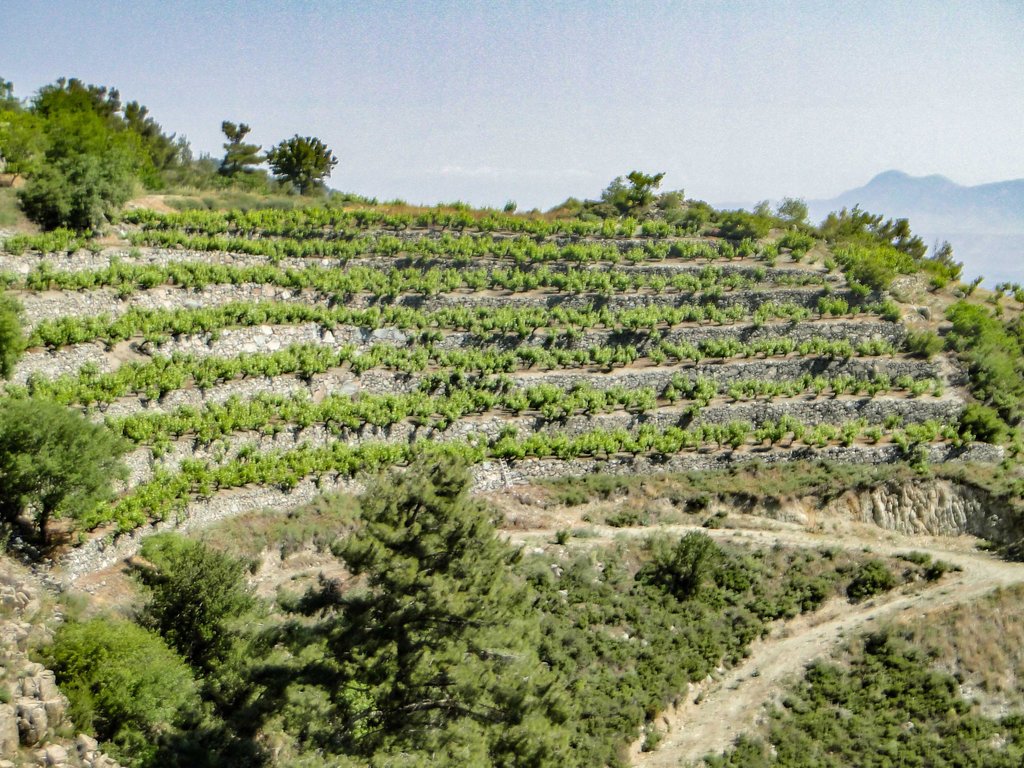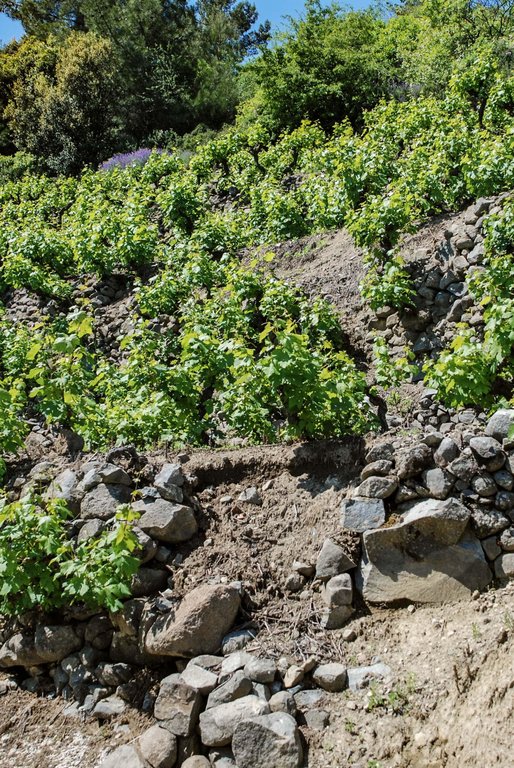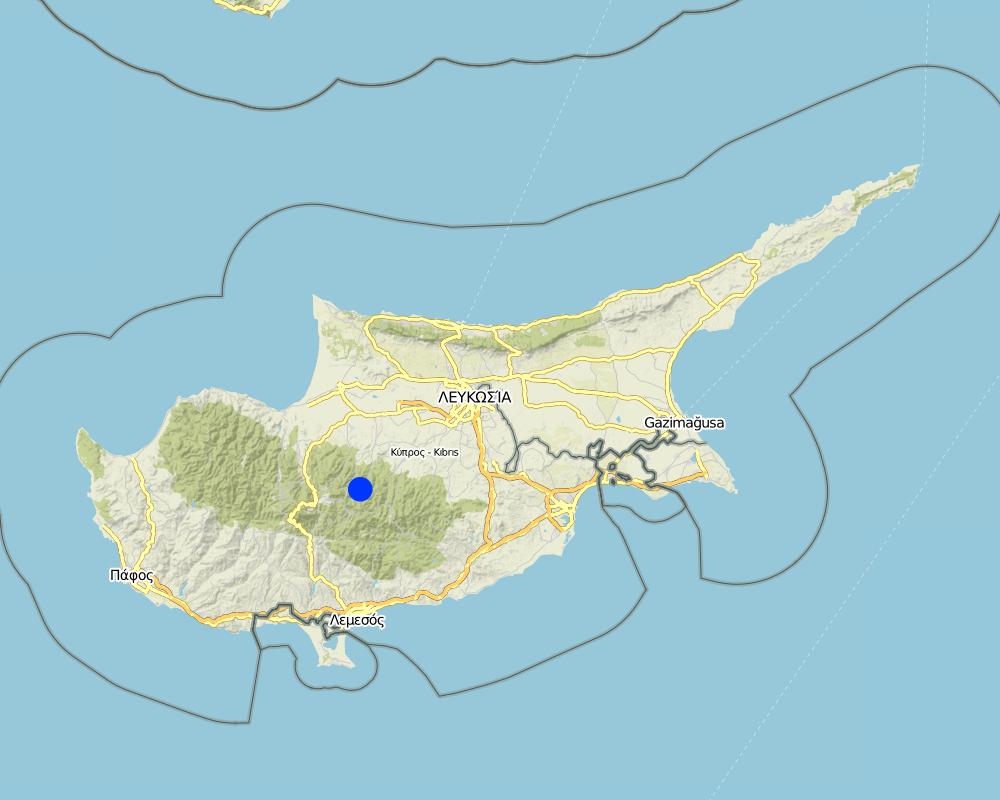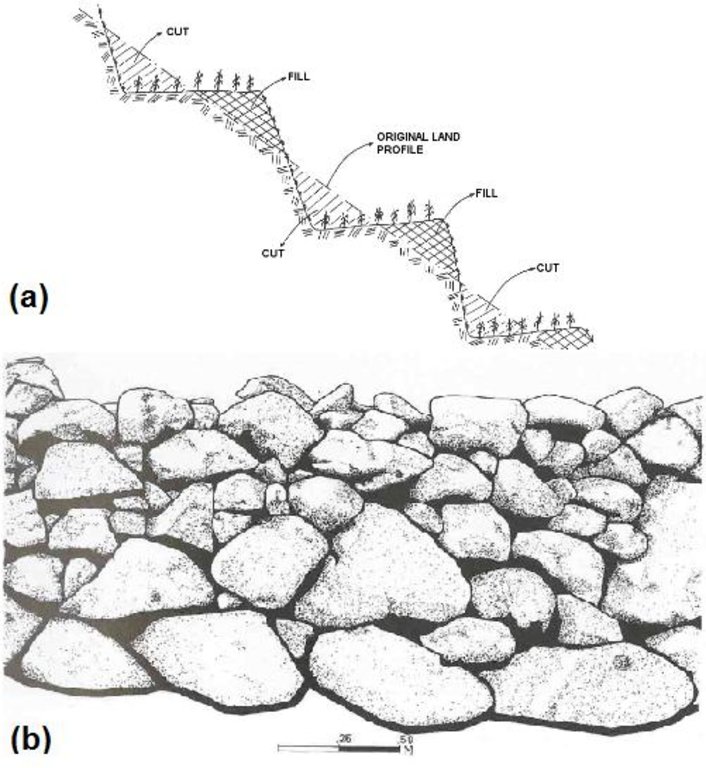Agricultural terraces with dry-stone walls [ប្រទេសស៊ីប]
- ការបង្កើត៖
- បច្ចុប្បន្នភាព
- អ្នកចងក្រង៖ Christos Zoumides
- អ្នកកែសម្រួល៖ –
- អ្នកត្រួតពិនិត្យច្រើនទៀត៖ Deborah Niggli, Alexandra Gavilano
Γεωργικές αναβαθμίδες με τοίχους ξερολιθιάς (Greek)
technologies_1702 - ប្រទេសស៊ីប
ពិនិត្យមើលគ្រប់ផ្នែក
ពង្រីកមើលទាំងអស់ បង្រួមទាំងអស់1. ព័ត៌មានទូទៅ
1.2 ព័ត៌មានលម្អិតពីបុគ្គលសំខាន់ៗ និងស្ថាប័នដែលចូលរួមក្នុងការវាយតម្លៃ និងចងក្រងឯកសារនៃបច្ចេកទេស
អ្នកជំនាញឯកទេស SLM:
Bruggeman Adriana
The Cyprus Institute
ប្រទេសស៊ីប
អ្នកជំនាញឯកទេស SLM:
Camera Corrado
The Cyprus Insitute
ប្រទេសស៊ីប
ឈ្មោះគម្រោងដែលបានចងក្រងឯកសារ/ វាយតម្លៃលើបច្ចេកទេស (បើទាក់ទង)
Preventing and Remediating degradation of soils in Europe through Land Care (EU-RECARE )ឈ្មោះអង្គភាពមួយ (ច្រើន) ដែលបានចងក្រងឯកសារ/ វាយតម្លៃបច្ចេកទេស (បើទាក់ទង)
The Cyprus Institute (The Cyprus Institute) - ប្រទេសស៊ីប1.3 លក្ខខណ្ឌទាក់ទងទៅនឹងការប្រើប្រាស់ទិន្នន័យដែលបានចងក្រងតាមរយៈ វ៉ូខេត
អ្នកចងក្រង និង(បុគ្គលសំខាន់ៗ)យល់ព្រមទទួលយកនូវលក្ខខណ្ឌនានាទាក់ទងទៅនឹងការប្រើប្រាស់ទិន្នន័យដែលបានចងក្រងតាមរយៈវ៉ូខេត:
បាទ/ចា៎
1.4 សេចក្តីប្រកាសស្តីពីចីរភាពនៃការពណ៌នាពីបច្ចេកទេស
តើបច្ចេកទេសដែលបានពណ៌នានេះមានបញ្ហាដែលផ្តោតលើការធ្លាក់ចុះគុណភាពដី, បើដូច្នេះវាមិនអាចត្រូវបានប្រកាសថាជាបច្ចេកទេសនៃការគ្រប់គ្រងប្រកបដោយចីរភាពទេ?
ទេ
1.5 ការយោងទៅលើកម្រងបញ្ជីសំណួរ (មួយ ឬច្រើន) នៃវិធីសាស្ត្រផ្សព្វផ្សាយ SLM (ដែលបានចងក្រងដោយទស្សនៈពិភពលោកស្តីពីវិធីសាស្ត្រ និងបច្ចេកទេសងអភិរក្ស WOCAT)
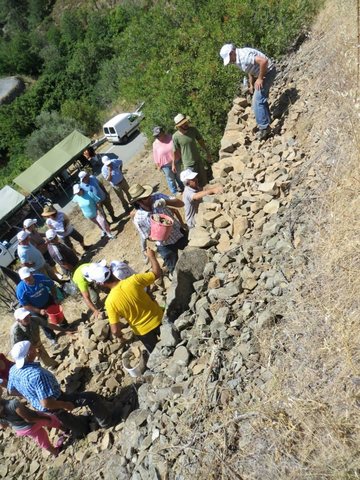
Community-based maintenance and rehabilitation of agricultural terraces in … [ប្រទេសស៊ីប]
Maintenance and rehabilitation of traditional dry-stone terrace walls for agricultural use, through science-society cooperation, community engagement and motivation, and assistance to land users.
- អ្នកចងក្រង៖ Christos Zoumides
2. ការពណ៌នាពីបច្ចេកទេស SLM
2.1 ការពណ៌នាដោយសង្ខេបពីបច្ចេកទេស
និយមន័យបច្ចេកទេស:
Dry-stone terraces built to create agricultural land, minimise soil erosion and retain soil moisture on steep mountain slopes.
2.2 ការពណ៌នាលម្អិតពីបច្ចេកទេស
ការពណ៌នា:
Dry-stone terraces consist of a series of nearly levelled platforms built along contour lines at suitable intervals. These structures characterise a large part of the landscape in Cyprus, and especially in communities around Troodos Mountains where large areas have been converted to agricultural terraces. The typical terraces found in the study-area are narrow (1-3 m) to medium-base (3-6 m) bench terraces, constructed by cutting and filling in slopes between 20-40%. The terraces are supported by walls, whereby stone is the only construction material without any binding mortar.
Terracing is one of the oldest means of cultivating slopes while saving soil and water. Due to the steep terrain of Troodos Mountains, the establishment of terraces acts as sediment trap storing the washed-off soil material within the slope. In general, terraces were created to stop or reduce the degrading effect of soil erosion by intercepting and controlling the surface run-off velocity and by facilitating its slower infiltration. In such a way, the sediment that accumulates behind the terraces has created suitable land for farming. In addition, the construction of dry-stone walls serves a dual purpose: to clear the land from large rock and stones, and to enhance the stability of the bench terraces against loss of top-soil. This is a type of technology that was very much used in the past and seen today as an important cultural landscape and heritage for these communities.
The construction of dry-stone walls was usually completed by the family who owned the field. Men undertook the building while the rest of the family carried the stones; assistance was also offered by relatives and friends of the family. First, the topography, the height and shape of the terrace is evaluated. Using a fuse, the craftsman shapes a straight line which would follow while building the wall. The foundations are created by excavating a pit of ~0.3-0.5 m, depending on the type of soils and the size of the wall; fuse, pick, mattock and shovel are the typical tools used. The pit is filled with large, irregular-shaped stones.
The stones are used in their natural shape for the construction of the walls without any processing. They are separated according to their shape, size and texture. The stones usually come from the cleaning of fields which will be cultivated or from a small-scale quarrying of the mountain slope using pick and lever. Large and irregular stones are used for the foundations, and the more regular ones for the construction of walls. The smaller stones are placed in between the large stones as the linchpin, to provide better stability to the structure.
The wall follows the land inclination and is laid over the foundation. Large stones are placed on the lower courses of the wall and on the exterior side. The stones are placed by hand one over the other, while smaller stones and rubbles are put between them in order to achieve more stability and better positioning; the stones cross both vertically and horizontally in order to avoid the creation of columns which will make the structure less stable. The wall is built lengthwise following the foundations and it reclines inwards; declination from the foundations does not exceed 5%. The back side of the wall is filled-up with more irregular stones which are not suitable to be placed on the front side. The filling connects the wall with the soil and stabilises the structure, and allows the drainage of water that is collected from the terrace and is discharged through the stones of the wall.
Terrace farming of grapes, nut and fruit trees, along with natural (mainly sclerophylous) vegetation constitute the predominant land uses in this area. The total population in the eight mountain communities of Peristerona Watershed has decreased by more than 50% over the past 30 years. The depopulation of mountain communities is associated with the urbanisation trends and the high farming costs which led to the gradual reduction of agricultural activities in the area. These socio-economic attributes form the main constraining factors for soil conservation. Thus, although terraces have a particularly beneficial effect in maintaining the productive capacity of soils in these communities, the significant changes in the socio-economic structure of the agricultural population over the last decades and the high maintenance and labour required, has led farmers to gradually abandon terrace farming. Consequently, many of the mountain terraces are no longer cultivated and dry stone walls are not maintained, causing sometimes a domino effect of collapsing terraces.
2.3 រូបភាពនៃបច្ចេកទេស
2.5 ប្រទេស/តំបន់/ទីតាំងកន្លែង ដែលបច្ចេកទេសត្រូវបានអនុវត្ត និងបានគ្រប់ដណ្តប់ដោយការវាយតម្លៃនេះ
ប្រទេស:
ប្រទេសស៊ីប
តំបន់/រដ្ឋ/ខេត្ត:
Nicosia
បញ្ជាក់បន្ថែមពីលក្ខណៈនៃទីតាំង:
Northeast Pitsilia
បញ្ជាក់ពីការសាយភាយនៃបច្ចេកទេស:
- ត្រូវបានផ្សព្វផ្សាយត្រឹមតំបន់មួយ
ប្រសិនបើបច្ចេកទេសត្រូវបានសាយភាយពាសពេញតំបន់ណាមួយ បញ្ជាក់ទំហំផ្ទៃដីអនុវត្តន៍ (គិតជា គ.ម2):
30,9
ប្រសិនបើមិនច្បាស់ពីទំហំផ្ទៃដី សូមធ្វើការប៉ាន់ប្រម៉ាណ:
- 10-100 គម2
មតិយោបល់:
Total area covered by the SLM Technology is 30.9 km2.
Dry-stone terraces characterise a large part of the landscape in Cyprus, and especially in communities around Troodos Mountains. There is a large variety of dry-stone terraces on the island, according to the morphology of each area and the accessibility to raw materials. The information reported here refer to the mountain communities in Northeast Pitsilia and particularly to the Peristerona watershed upstream communities (RECARE project case-study site).
Map
×2.6 កាលបរិច្ឆេទនៃការអនុវត្ត
ប្រសិនបើមិនច្បាស់ឆ្នាំ សូមបញ្ជាក់កាលបរិច្ឆេទដែលប្រហាក់ប្រហែល:
- ច្រើនជាង 50 ឆ្នាំមុន (ប្រពៃណី)
2.7 ការណែនាំពីបច្ចេកទេស
សូមបញ្ជាក់តើបច្ចេកទេសត្រូវបានណែនាំឱ្យអនុវត្តដោយរបៀបណា:
- ជាផ្នែកនៃប្រព័ន្ធប្រពៃណី (> 50 ឆ្នាំ)
មតិយោបល់ (ប្រភេទនៃគម្រោង ។ល។):
Dry-stone terracing has been practice for centuries in Cyprus and in the study area. The rehabilitation of dry-stone terraces through community-based activities has been introduced in 2015 by the RECARE project case-study team and the local communities.
3. ចំណាត់ថ្នាក់នៃបច្ចេកទេស SLM
3.1 គោលបំណងចម្បង (១ ឬច្រើន) នៃបច្ចេកទេសនេះ
- កាត់បន្ថយ, បង្ការ, ស្តារឡើងវិញនូវការធ្លាក់ចុះគុណភាពដី
3.2 ប្រភេទដីប្រើប្រាស់មួយប្រភេទ (ច្រើនប្រភេទ) ដែលបានអនុវត្តបច្ចេកទេស

ដីដាំដំណាំ
- ប្រភេទដើមឈើធំៗ និងដើមឈើតូចៗ
ប្រភេទដើមឈើធំៗ និងដើមឈើតូចៗ - បញ្ជាក់ប្រភេទ:
- ផ្លែឈើផ្សេងៗ
- ទំពាំងបាយជូ
- ដើមឈើយកគ្រាប់ (brazil nuts, pistachio, walnuts, almonds, etc.)
ចំនួនសារដែលដាំដំណាំក្នុងមួយឆ្នាំ:
- 1
សូមបញ្ជាក់:
Longest growing period in days: 240, Longest growing period from month to month: Mid March to early November (grapevines)
មតិយោបល់:
Major land use problems (compiler’s opinion): Soil erosion by water from degraded and collapsing dry-stone terraces.
Loss of productive capacity.
Major land use problems (land users’ perception): Gradual collapse of dry-stone walls.
Root rot and yield failure as a result of water-logging which is linked to poor drainage in terraced fields.
3.4 ការផ្គត់ផ្គង់ទឹក
ការផ្គត់ផ្គង់ទឹកនៅកន្លែងអនុវត្តបច្ចេកទេស:
- ទឹកភ្លៀង
3.5 ក្រុម SLM ដែលបច្ចេកទេសស្ថិតនៅក្នុង
- វិធានការអនុវត្តកាត់ទទឹងទីជម្រាល
3.6 វិធានការ SLM ដែលបញ្ចូលនូវបច្ចេកទេស

វិធានការរចនាស័ម្ពន្ធ
- S1: ការធ្វើដីថ្នាក់ៗតាមជម្រាលភ្នំ
មតិយោបល់:
Main measures: structural measures
3.7 កំណត់ប្រភេទនៃការធ្លាក់ចុះគុណភាពដីសំខាន់ៗដែលបច្ចេកទេសនេះបានដោះស្រាយ

ការហូរច្រោះដីដោយសារទឹក
- Wt: ការបាត់ដីស្រទាប់លើដោយការហូរច្រោះ
- Wo: ផលប៉ះពាល់នៃការធ្លាក់ចុះគុណភាពកន្លែងឆ្ងាយ
មតិយោបល់:
Main type of degradation addressed: Wt: loss of topsoil / surface erosion
Secondary types of degradation addressed: Wo: offsite degradation effects
Main causes of degradation: other human induced causes (specify) (Gradual abandonment of mountain agriculture), other natural causes (avalanches, volcanic eruptions, mud flows, highly susceptible natural resources, extreme topography, etc.) specify (Steep mountain terrain)
Secondary causes of degradation: land tenure (Small, fractured agricultural plots), governance / institutional (Lack of institutions for terrace maintenance)
3.8 ការពារ កាត់បន្ថយ ឬស្តារឡើងវិញនៃការធ្លាក់ចុះគុណភាពដី
បញ្ជាក់ពីគោលដៅរបស់បច្ចេកទេស ដែលផ្តោតទៅការធ្លាក់ចុះគុណភាពដី:
- ការការពារការធ្លាក់ចុះគុណភាពដី
- ការជួសជុល/ ស្តារឡើងវិញនៃឱនភាពដីធ្ងន់ធ្ងរ
4. បច្ចេកទេសជាក់លាក់ សកម្មភាពអនុវត្ត ធាតុចូល និងថ្លៃដើម
4.1 គំនូសបច្ចេកទេសនៃបច្ចេកទេសនេះ
លក្ខណៈពិសេសនៃបច្ចេកទេស (ទាក់ទងនឺងគំនូរបច្ចេកទេស):
(a) The typical terraces found in the study-area are narrow (1-3 m) to medium-base (3-6 m) bench terraces, constructed by cutting and filling in slopes between 20-40%. The height of terraces range between 0.75 to 2 meters, depending on the steepness and the morphology of each slope.
(b) The terraces are supported by walls, whereby stone - typically volcanic rock - is the only construction material without any binding mortar. Large and irregular stones are used for the foundations, while the more regular for the construction of walls. The smaller stones are placed in between the large stones as the linchpin, to provide better stability to the structure. The wall is built lengthwise following the foundations and it reclines inwards; declination from the foundations does not exceed 5%. The back side of the wall is filled-up with more irregular stones which are not suitable to be placed on the front side. The filling connects the wall with the soil and stabilises the structure, and allows the drainage of water that is collected from the terrace and is discharged through the stones of the wall.
Northeast Pitsilia, Nicosia
Technical knowledge required for land users: moderate (To maintain dry-stone wall terraces)
Technical knowledge required for Dry-stone artisans (experts builders): high (To reconstruct collapsed terraces)
Main technical functions: reduction of slope angle, sediment retention / trapping, sediment harvesting
Secondary technical functions: increase of infiltration, increase / maintain water stored in soil
Terrace: bench level
Vertical interval between structures (m): 1-2
Spacing between structures (m): 1-15
Construction material (stone): Natural volcanic rock available on the sites (mostly gabbro & diabase)
Lateral gradient along the structure: 0-8%
ឈ្មោះអ្នកនិពន្ធ:
a: FAO, 2000 & b: TPH, 2007
4.2 ព័ត៌មានទូទៅដែលពាក់ព័ន្ធនឹងការគណនាធាតុចូល និងថ្លៃដើម
ផ្សេងៗ/ រូបិយប័ណ្ណជាតិ (បញ្ជាក់):
Euro
បើពាក់ព័ន្ធសូមកំណត់អត្រាប្តូរប្រាក់ពីដុល្លាទៅរូបិយប័ណ្ណតំបន់ (ឧ. 1 ដុល្លារ = 79.9 រៀលនៃរូបិយប័ណ្ណប្រេស៊ីល) ៖ 1 ដុល្លារ =:
0,88
កំណត់ថ្លៃឈ្នួលជាមធ្យមនៃការជួលកម្លាំងពលកម្មក្នុងមួយថ្ងៃ:
72.97
4.3 សកម្មភាពបង្កើត
| សកម្មភាព | រយៈពេល (រដូវកាល) | |
|---|---|---|
| 1. | Land leveling and foundation | Early autumn or late spring |
| 2. | Collection and transfer of stones | Early autumn or late spring |
| 3. | Construction of stone-wall | Early autumn or late spring |
4.4 ថ្លៃដើម និងធាតុចូលដែលត្រូវការសម្រាប់ការបង្កើតបច្ចេកទេស
| បញ្ជាក់ពីធាតុចូល | ឯកតា | បរិមាណ | ថ្លៃដើមក្នុងមួយឯកតា | ថ្លៃធាតុចូលសរុប | % នៃថ្លៃដើមដែលចំណាយដោយអ្នកប្រើប្រាស់ដី | |
|---|---|---|---|---|---|---|
| កម្លាំងពលកម្ម | Labour | 4000,0 | 45,6 | 182400,0 | 100,0 | |
| ថ្លៃដើមសរុបក្នុងការបង្កើតបច្ចេកទេស | 182400,0 | |||||
| ថ្លៃដើមសរុបក្នុងការបង្កើតបច្ចេកទេសគិតជាដុល្លារ | 207272,73 | |||||
មតិយោបល់:
Duration of establishment phase: 83 month(s)
4.5 សកម្មភាពថែទាំ
| សកម្មភាព | ពេលវេលា/ ភាពញឹកញាប់ | |
|---|---|---|
| 1. | Repairing collapsed walls | Early autumn (before onset of rains), only on collapsed walls |
4.6 កំណត់ថ្លៃដើមសម្រាប់ការថែទាំ/ សកម្មភាពរបស់បច្ចេកទេស (ក្នុងរយៈពេលមួយឆ្នាំ)
| បញ្ជាក់ពីធាតុចូល | ឯកតា | បរិមាណ | ថ្លៃដើមក្នុងមួយឯកតា | ថ្លៃធាតុចូលសរុប | % នៃថ្លៃដើមដែលចំណាយដោយអ្នកប្រើប្រាស់ដី | |
|---|---|---|---|---|---|---|
| កម្លាំងពលកម្ម | Labour | 200,0 | 9,12 | 1824,0 | 100,0 | |
| ថ្លៃដើមសរុបសម្រាប់ការថែទាំដំណាំតាមបច្ចេកទេស | 1824,0 | |||||
| ថ្លៃដើមសរុបសម្រាប់ការថែទាំដំណាំតាមបច្ចេកទេសគិតជាដុល្លារ | 2072,73 | |||||
មតិយោបល់:
Machinery/ tools: Wedge, hammer, pick, hoe and bucket are the typical tools used for by stone builders for the construction and maintenance of dry-stone terraces.
The costs estimates are averages and were calculated for the length of terrace structures, i.e. per running meter of terrace walls. The average height of dry-stone walls is 1.5 meter and it takes approximately 5 hours/meter for a builder to fully construct it. This includes 1 hour/meter for land levelling and foundation, 1 hour/meter for the collection and transfer of the necessary stones and 3 hours/meter for building the wall. Stones are abundant in the area; builders do not charge for the stones but for the time required to collect and transfer. Also, each builder has its own tools (i.e. wedge, hammer, pick, hoe and bucket). Terrace builders charge 8 €/hour (or 9.12 $/hour). On average, there are approximately 4000 running meters of terrace walls per hectare. The above information is used to convert the construction cost per hectare.
Maintenance activities include reconstruction of the terrace walls, only in case of collapsing. The reconstruction takes 1 hour/meter. For the annual maintenance estimates, it is assumed that 200 out of 4000 meters of terrace walls per hectare (or 5%) will require maintenance. In other words, a newly constructed wall will be maintained once every 20 years, on average.
4.7 កត្តាសំខាន់បំផុតដែលមានឥទ្ធិពលដល់ការចំណាយ
ពណ៌នាពីកត្តាប៉ះពាល់ចម្បងៗទៅលើថ្លៃដើម:
The principal input cost for the construction and maintenance of terraces is manual labour. There are only few dry-stone builders in the area.
5. លក្ខណៈបរិស្ថានធម្មជាតិ និងមនុស្ស
5.1 អាកាសធាតុ
បរិមាណទឹកភ្លៀងប្រចាំឆ្នាំ
- < 250 មម
- 251-500 មម
- 501-750 មម
- 751-1,000 មម
- 1,001-1,500 មម
- 1,501-2,000 មម
- 2,001-3,000 មម
- 3,001-4,000 មម
- > 4,000 មម
លក្ខណៈពិសេស/ មតិយោបល់លើរដូវភ្លៀង:
500-750mm: Seasonal rainfall (October to May) - Peristerona watershed upstream
250-500mm: Seasonal rainfall (October to May) - Peristerona watershed downstream
តំបន់កសិអាកាសធាតុ
- មានភ្លៀងមធ្យម
- មានភ្លៀងតិចតួច
Thermal climate class: subtropics. Below 1000m a.s.l.
Thermal climate class: temperate. Above 1000m a.s.l.
5.2 សណ្ឋានដី
ជម្រាលជាមធ្យម:
- រាបស្មើ (0-2%)
- ជម្រាលតិចតួច (3-5%)
- មធ្យម (6-10%)
- ជម្រាលខ្ពស់បន្តិច (11-15%)
- ទីទួល (16-30%)
- ទីទួលចោត (31-60%)
- ទីទួលចោតខ្លាំង (>60%)
ទម្រង់ដី:
- ខ្ពង់រាប
- កំពូលភ្នំ
- ជម្រាលភ្នំ
- ជម្រាលទួល
- ជម្រាលជើងភ្នំ
- បាតជ្រលងភ្នំ
តំបន់តាមរយៈកម្ពស់ :
- 0-100 ម
- 101-500 ម
- 501-1,000 ម
- 1,001-1,500 ម
- 1,501-2,000 ម
- 2,001-2,500 ម
- 2,501-3,000 ម
- 3,001-4,000 ម
- > 4,000 ម
បញ្ជាក់ថាតើបច្ចេកទេសនេះត្រូវបានអនុវត្តន៍នៅក្នុង:
- មិនពាក់ព័ន្ធទាំងអស់
5.3 ដី
ជម្រៅដីជាមធ្យម:
- រាក់ខ្លាំង (0-20 សម)
- រាក់ (21-50 សម)
- មធ្យម (51-80 សម)
- ជ្រៅ (81-120 សម)
- ជ្រៅខ្លាំង (> 120 សម)
វាយនភាពដី (ស្រទាប់លើ):
- គ្រើម/ មានពន្លឺ (ខ្សាច់)
- មធ្យម (ល្បាយ, ល្បាប់)
សារធាតុសរីរាង្គនៅស្រទាប់ដីខាងលើ:
- មធ្យម (1-3%)
- ទាប (<1%)
5.4 ទឹកដែលអាចទាញមកប្រើប្រាស់បាន និងគុណភាពទឹក
នីវ៉ូទឹកក្រោមដី:
> 50 ម
ទឹកលើដីដែលអាចទាញយកប្រើប្រាស់បាន:
កម្រិតមធ្យម
គុណភាពទឹក (មិនបានធ្វើប្រត្តិកម្ម):
ទឹកពិសារដែលមានគុណភាពល្អ
5.5 ជីវៈចម្រុះ
ភាពសម្បូរបែបនៃប្រភេទ:
- កម្រិតមធ្យម
5.6 លក្ខណៈនៃអ្នកប្រើប្រាស់ដីដែលអនុវត្តបច្ចេកទេស
នៅមួយកន្លែង ឬពនេចរ :
- នៅមួយកន្លែង
ទីផ្សារនៃប្រព័ន្ធផលិតកម្ម:
- ពាក់កណ្តាលពាណិជ្ជកម្ម (ផ្គត់ផ្គង់ខ្លួនឯង/ ពាណិជ្ជកម្ម)
ចំណូលក្រៅកសិកម្ម:
- 10-50% នៃចំណូល
កម្រិតជីវភាព:
- មធ្យម
ឯកជន ឬក្រុម:
- ធ្វើខ្លួនឯង/ គ្រួសារ
កម្រិតប្រើប្រាស់គ្រឿងយន្ត:
- ប្រើកម្លាំងពលកម្ម
- គ្រឿងយន្ត/ ម៉ាស៊ីន
យេនឌ័រ:
- ស្ត្រី
- បុរស
សូមបញ្ជាក់ពីលក្ខណៈពាក់ព័ន្ធផ្សេងទៀតអំពីអ្នកប្រើប្រាស់ដី:
Land users applying the Technology are mainly common / average land users
Population density: 10-50 persons/km2
Annual population growth: negative; 4%
100% of the land users are average wealthy.
Off-farm income specification: Farming is a part-time activity for most land users in the area.
5.7 ទំហំផ្ទៃដីជាមធ្យមនៃដីប្រើប្រាស់ដោយអ្នកប្រើប្រាស់ដី ក្នុងការអនុវត្តបច្ចេកទេស
- < 0.5 ហិកតា
- 0.5-1 ហិកតា
- 1-2 ហិកតា
- 2-5 ហិកតា
- 5-15 ហិកតា
- 15-50 ហិកតា
- 50-100 ហិកតា
- 100-500 ហិកតា
- 500-1,000 ហិកតា
- 1,000-10,000 ហិកតា
- > 10,000 ហិកតា
តើផ្ទៃដីនេះចាត់ទុកជាទំហំកម្រិតណាដែរ ខ្នាតតូច មធ្យម ឬខ្នាតធំ (ធៀបនឹងបរិបទតំបន់)?
- ខ្នាតតូច
មតិយោបល់:
The average for Cyprus is 3.4 ha/holding
5.8 ភាពជាម្ចាស់ដី កម្មសិទ្ធប្រើប្រាស់ដី និងកម្មសិទ្ធប្រើប្រាស់ទឹក
ភាពជាម្ចាស់ដី:
- ឯកជន មានកម្មសិទ្ធ
កម្មសិទ្ធិប្រើប្រាស់ដី:
- ឯកជន
មតិយោបល់:
Agricultural land is privately owned
5.9 ការប្រើប្រាស់សេវាកម្ម និងហេដ្ឋារចនាសម្ព័ន្ធ
សុខភាព:
- មិនល្អ
- មធ្យម
- ល្អ
ការអប់រំ:
- មិនល្អ
- មធ្យម
- ល្អ
ជំនួយបច្ចេកទេស:
- មិនល្អ
- មធ្យម
- ល្អ
ការងារ (ឧ. ការងារក្រៅកសិដ្ឋាន):
- មិនល្អ
- មធ្យម
- ល្អ
ទីផ្សារ:
- មិនល្អ
- មធ្យម
- ល្អ
ថាមពល:
- មិនល្អ
- មធ្យម
- ល្អ
ផ្លូវ និងការដឹកជញ្ជូន:
- មិនល្អ
- មធ្យម
- ល្អ
ទឹកផឹក និងអនាម័យ:
- មិនល្អ
- មធ្យម
- ល្អ
សេវាកម្មហិរញ្ញវត្ថុ:
- មិនល្អ
- មធ្យម
- ល្អ
6. ផលប៉ះពាល់ និងការសន្និដ្ឋាន
6.1 ផលប៉ះពាល់ក្នុងបរិវេណអនុវត្តបច្ចេកទេសដែលកើតមាន
ផលប៉ះពាល់លើសេដ្ឋកិច្ចសង្គម
ផលិតផល
ផលិតកម្មដំណាំ
មតិយោបល់/ ការបញ្ជាក់:
Terraces create agricultural land for crop production in slopes. However, the establishment of terraces does not imply increased crop yield.
ផ្ទៃដីផលិតកម្ម
មតិយោបល់/ ការបញ្ជាក់:
Without terraces on mountain slopes, crop farming would have been almost impossible
ទឹកដែលអាចទាញមកប្រើប្រាស់បាន និងគុណភាពទឹក
តម្រូវការទឹកសម្រាប់ស្រោចស្រព
មតិយោបល់/ ការបញ្ជាក់:
Well constructed and maintained terraces improve water drainage and retain soil moisture.
ចំណូល និងថ្លៃដើម
ការចំណាយលើធាតុចូលកសិកម្ម
មតិយោបល់/ ការបញ្ជាក់:
More costly to grown on mountain terraces than in the plains. Also, maintenance of collapsed terrace walls is costly.
ចំណូលក្នុងកសិដ្ឋាន
មតិយោបល់/ ការបញ្ជាក់:
Farming in the study-site is practiced almost exclusively on terraces; well maintained terraces can increase farm income.
បន្ទុកការងារ
មតិយោបល់/ ការបញ្ជាក់:
Maintenance of collapsed terrace walls requires manual labour
ផលប៉ះពាល់ទៅលើវប្បធម៌សង្គម
សន្តិសុខស្បៀង/ ភាពគ្រប់គ្រាន់ខ្លួនឯង
មតិយោបល់/ ការបញ្ជាក់:
Partly for those land users that still practice mountain terrace farming.
ឱកាសវប្បធម៍
មតិយោបល់/ ការបញ្ជាក់:
When terraces are maintained/rehabilitated through community-based activities.
ឱកាសនៃការបង្កើតថ្មី
មតិយោបល់/ ការបញ្ជាក់:
When terraces are maintained/rehabilitated through community-based activities.
ស្ថាប័នសហគមន៍
មតិយោបល់/ ការបញ្ជាក់:
When terraces are maintained/rehabilitated through community-based activities.
ចំណេះដឹង SLM / ការធ្លាក់ចុះគុណភាពដី
មតិយោបល់/ ការបញ្ជាក់:
Dry-stone terracing is the typical soil conservation technology in the study-site
ការកាត់បន្ថយជម្លោះ
Contribution to human well-being
មតិយោបល់/ ការបញ្ជាក់:
Terraced landscapes in the Troodos mountains represent a longstanding tradition of self-sustained communities. In the past, terrace farming was a main activity and has contributed to the livelihoods and well-being of these communities. Nowadays, terrace farming is still practiced by much fewer land users, mainly on part-time basis.
ផលប៉ះពាល់ទៅលើអេកូឡូស៊ី
វដ្តទឹក/លំហូរ
ការប្រមូលស្តុកទុកទឹក
មតិយោបល់/ ការបញ្ជាក់:
One of the main functions of terraces.
លំហូរទឹកលើផ្ទៃដី
មតិយោបល់/ ការបញ្ជាក់:
One of the main functions of terraces.
ដី
គម្របដី
មតិយោបល់/ ការបញ្ជាក់:
When terraces are maintained
ការបាត់បង់ដី
មតិយោបល់/ ការបញ្ជាក់:
One of the main functions of terraces.
ជីវចម្រុះ៖ ដំណាំ, សត្វ
ភាពសម្បូរបែបនៃទីជំរក
មតិយោបល់/ ការបញ្ជាក់:
Dry-stone terraces create biodiversity habitats, especially for reptiles and arthropods
ការកាត់បន្ថយហានិភ័យនៃគ្រោះមហន្តរាយ និងគ្រោះអាកាសធាតុ
ហានិភ័យនៃភ្លើងឆេះព្រៃ
មតិយោបល់/ ការបញ្ជាក់:
Well maintained terraces have less weeds than abandoned terraces, thus reducing the fire risk
ផលប៉ះពាល់ទៅលើអេកូឡូស៊ីផ្សេងៗ
Abandoned or poorly maintained terraces can result in increased erosion, e.g. through the collapsing
6.2 ផលប៉ះពាល់ក្រៅបរិវេណអនុវត្តបច្ចេកទេសដែលកើតមាន
ទឹកជំនន់ខ្សែទឹកខាងក្រោម
មតិយោបល់/ ការបញ្ជាក់:
Upstream terraces can reduce to a certain extent reduced downstream flooding
កំណកល្បាប់ខ្សែទឹកខាងក្រោម
មតិយោបល់/ ការបញ្ជាក់:
Upstream terraces can reduce to a certain extent downstream siltation
ខូចខាតដល់ហេដ្ឋារចនាសម្ព័ន្ធសាធារណៈ/ឯកជន
មតិយោបល់/ ការបញ្ជាក់:
Well maintain terraces reduce damage (erosion) on public (e.g. roads) and private (e.g. neighbours fields) infrastructure
6.3 ភាពប្រឈម និងភាពរួសនៃបច្ចេកទេសទៅនឹងការប្រែប្រួលអាកាសធាតុ និងគ្រោះអាកាសធាតុ/ គ្រោះមហន្តរាយ (ដែលដឹងដោយអ្នកប្រើប្រាស់ដី)
ការប្រែប្រួលអាកាសធាតុ
ការប្រែប្រួលអាកាសធាតុ
| រដូវកាល | កើនឡើង ឬថយចុះ | លក្ខណៈឆ្លើយតបនៃបច្ចេកទេសទៅនឹងការប្រែប្រួលអាកាសធាតុ | |
|---|---|---|---|
| សីតុណ្ហភាពប្រចាំឆ្នាំ | កើនឡើង | ល្អ |
គ្រោះអាកាសធាតុ (មហន្តរាយ)
គ្រោះមហន្តរាយធម្មជាតិ
| លក្ខណៈឆ្លើយតបនៃបច្ចេកទេសទៅនឹងការប្រែប្រួលអាកាសធាតុ | |
|---|---|
| ព្យុះភ្លៀងតាមតំបន់ | មិនល្អ |
| ព្យុះកំបុតត្បូងតាមតំបន់ | មិនស្គាល់ |
គ្រោះមហន្តរាយអាកាសធាតុ
| លក្ខណៈឆ្លើយតបនៃបច្ចេកទេសទៅនឹងការប្រែប្រួលអាកាសធាតុ | |
|---|---|
| រាំងស្ងួត | ល្អ |
គ្រោះមហន្តរាយទឹក
| លក្ខណៈឆ្លើយតបនៃបច្ចេកទេសទៅនឹងការប្រែប្រួលអាកាសធាតុ | |
|---|---|
| ទឹកជំនន់ទូទៅ (ទន្លេ) | មិនល្អ |
ផលវិបាកដែលទាក់ទងនឹងបរិយាកាសផ្សេងៗទៀត
ផលវិបាកដែលទាក់ទងនឹងបរិយាកាសផ្សេងៗទៀត
| លក្ខណៈឆ្លើយតបនៃបច្ចេកទេសទៅនឹងការប្រែប្រួលអាកាសធាតុ | |
|---|---|
| កាត់បន្ថយពេលដាំដុះ | ល្អ |
6.4 ការវិភាគថ្លៃដើម និងអត្ថប្រយោជន៍
តើផលចំណេញ និងថ្លៃដើមត្រូវបានប្រៀបធៀបគ្នាយ៉ាងដូចម្តេច (ទស្សនៈរបស់អ្នកប្រើប្រាស់ដី)?
រយៈពេលខ្លី:
អវិជ្ជមាន
រយៈពេលវែង:
វិជ្ជមាន
តើផលចំណេញ និងការថែទាំ/ ជួសជុលត្រូវបានប្រៀបធៀបគ្នាយ៉ាងដូចម្តេច (ទស្សនៈរបស់អ្នកប្រើប្រាស់ដី)?
រយៈពេលខ្លី:
អវិជ្ជមានតិចតួច
រយៈពេលវែង:
វិជ្ជមាន
6.5 ការទទួលយកបច្ចេកទេស
- > 50%
បើអាច សូមបញ្ជាក់ពីបរិមាណ (ចំនួនគ្រួសារ និង/ ឬតំបន់គ្របដណ្តប់):
90% of the land user families and 8% of the stated area
ក្នុងចំណោមគ្រួសារទាំងអស់ដែលបានអនុវត្តបច្ចេកទេស តើមានប៉ុន្មានគ្រួសារដែលចង់ធ្វើដោយខ្លួនឯង ដោយមិនទទួលបានសម្ភារៈលើកទឹកចិត្ត/ប្រាក់ឧបត្ថម្ភ?:
- 11-50%
មតិយោបល់:
10% of land user families have adopted the Technology without any external material support
90% of land user families have adopted the Technology with external material support
Comments on acceptance with external material support: The majority of existing terraces in the area were subsidized.
There is a little trend towards spontaneous adoption of the Technology
Comments on adoption trend: There are very few farmers that maintain existing terraces or construct new ones.
6.7 ភាពខ្លាំង/ គុណសម្បត្តិ/ ឱកាសនៃបច្ចេកទេស
| ភាពខ្លាំង/ គុណសម្បត្តិ/ ឱកាស ទស្សនៈរបស់បុគ្គលសំខាន់ៗ |
|---|
| Indigenous technology of great agro-ecological value, adapted to local conditions. |
| Soil maintained on steep mountain slopes, thus reducing soil loss due to water erosion. |
| Terraces maintain the productive capacity of soils on steep slopes. |
| Water retention and longer storage of soil moisture, thus improving water use efficiency. |
| Terraces are part of cultural landscapes and heritage |
6.8 ភាពខ្សោយ/ គុណវិបត្តិ/ ហានិភ័យនៃបច្ចេកទេស និងវិធីសាស្ត្រដោះស្រាយ
| ភាពខ្សោយ/ គុណវិបត្តិ/ ហានិភ័យ ទស្សនៈរបស់អ្នកចងក្រងឬបុគ្គលសំខាន់ៗ | តើបច្ចេកទេសទាំងនោះបានដោះស្រាយបញ្ហាដូចម្តេច? |
|---|---|
| Maintenance of dry-stone wall terraces is costly and labour intensive. | Promote community-based terrace maintenance and utilise available community/subsidy funds for small cash compensation to terrace experts. |
| Terrace maintenance requires expert knowledge. | Motivate the younger generation to engage in part-time terrace farming. |
| Aging of the dry-stone experts. | Train young land users/owners on dry-stone terracing. |
| Technology does not lend itself to mechanisation. | Not possible to overcome. |
7. ឯកសារយោង និងវេបសាយ
7.1 វិធីសាស្ត្រ/ ប្រភពនៃព័ត៌មាន
- ការសម្ភាសន៍ជាមួយអ្នកប្រើប្រាស់ដី
តើពេលណាដែលទិន្នន័យបានចងក្រង (នៅទីវាល)?
01/09/2015
7.2 ឯកសារយោងដែលបានចេញផ្សាយ
ចំណងជើង អ្នកនិពន្ធ ឆ្នាំ ISBN:
FAO, 2000. Manual on integrated soil management and conservation practices. FAO Land and Water Bulletin 8, Rome, Italy: 230 pp.TPH, 2007. Dry stone constructions of Cyprus. PIO, Nicosia.
ការតភ្ជាប់ និងម៉ូឌុល
ពង្រីកមើលទាំងអស់ បង្រួមទាំងអស់ការតភ្ជាប់

Community-based maintenance and rehabilitation of agricultural terraces in … [ប្រទេសស៊ីប]
Maintenance and rehabilitation of traditional dry-stone terrace walls for agricultural use, through science-society cooperation, community engagement and motivation, and assistance to land users.
- អ្នកចងក្រង៖ Christos Zoumides
ម៉ូឌុល
គ្មានម៉ូឌុល


